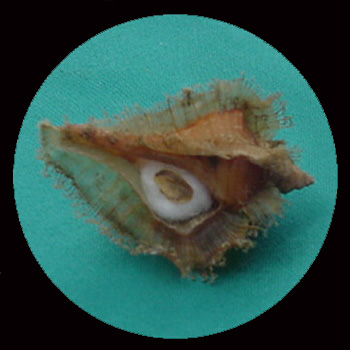|
Cymatium
ranzani
(Bianconi, 1850)
|
|
Class:
Gastropoda
Family:
Ranellidae
Species:
Cymatium ranzani (Bianconi,
1850)
English
Name: Ranzani's Triton
Locality:
Zanzibar
Image:
Sony Mavica digital camera.
|

|
|
Cymatium
ranzani (Bianconi, 1850) is a member of the large and diverse
family Ranellidae, which is also known as Cymatiidae:
in English, the Triton family. The Ranellids (when referring to
the members of a family, the suffix ae is replaced by an s)
include the famous Trumpet Triton shell, Charonia tritonis
(Linne, 1758) which is widely used in the Pacific as a
musical instrument, as well as the Truly Twisted genus Distorsio,
which will be featured in a future article. Cymatium ranzani is
an uncommon moderately deep-water species which grows up to 8 inches,
but which is very seldom collected as an adult. The specimen illustrated
above is just a baby (i.e., (i.e., a juvenile, in tech-speak),
about 70mm, and nicely exhibits the species' periostracum (see below),
which is hairy only on the varcies of the shell, which are very prominent
in most species of Cymatiidae, and are structures created by
a thickening of the lip which occurs after periods of rapid growth,
and are useful for added strength, for the entire shell as well as just
the lip.
|
|
Most collectors
like their specimens to be as close to perfect as possible. However,
the sea is very harsh place to live in practice, and the shell's
surface is subjected to a wide variety of hazards such as attacks by
other organisms, (some of which wish to make a meal of the mollusc inside,
and others who simply want a place to settle down and attach to (called
a "substrate")), variable Calcium carbonate concentration (CaCO3 - the
substance molluscs and other organisms such as star fish and sea urchins
use to make their shells: if it is too low, the shell is dissolved,
or is at best very difficult to capture from the water!), high
acidity in some fresh and brackish waters (acidity dissolves the shell
if it is exposed - NOT a great thing for a mollusc trying to survive
intact!), and abrasive sand and silt. The Periostracum,
which our "Mollusc of the moment" for today displays so well, is designed
to protect the shell from many of these dangers. It is made of
a substance called "conchiolin", which is a tough, outer layer of protein
that is secreted from the leading edge of the mantle, and clings tightly
to the shell, often sealing it off completely, effectively preventing
the shell from coming into contact with the water which could dissolve
it, the sand or silt which could erode it (something shell collectors
really appreciate!!), and organisms that wish to find a home or a meal!
(although its protection from the later is often minimal!! After
all, if a predator can bore through a shell, it can usually handle a
bit of concholin!!). The protein Concholin is made of, is similar
to the material our own bodies use to make hair and fingernails.
|
| Shell
collectors often remove the periostracum, usually via chlorine bleach,
which dissolves it and uncovers the color, pattern and gloss of the shell.
However, in landsnails (which must after all deal with rain, acid or otherwise!),
many bivalves (some bivalves lack a perio. entirely - Pectinidae
(scallops), for example - while others have an extremely thick layer,
especially those that live at great depths, where there is less available
CaCO3, or in fresh water, which is almost always acidic to some degree
in nature, since rain contains carbonic acid formed from the CO2 in the
atmosphere), and some gastropods such as the "Hairy Triton", Cymatium
pileare Linne, the periostracum is a vital part of the shell, and
is retained. On landsnails, it actually contains the pigments that
form the pattern and colors of the shell, and clings to the shell
like a second skin, requiring no preservation: it's on there for good!
However, for marine species it is necessary to preserve the perio., or
else it will dry out and either fall off, or in some cases break the fragile
shell underneath as it shrinks and cracks. The best way to preserve
a shell's Periostracum is to soak it in a solution of glycerin for a week
or so, and periodically repeat the process , since the glycerin will eventually
evaporate. In Scientific collections, it is simply preserved in
alcohol, usually with the animal as well, in a solution of 70 - 90% alcohol
(ethanol or propanol work best) - permanently picked. |
| |
|
